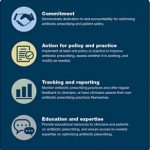- Antimicrobial Resistance
- AUR Module / Meaningful Use
- Antimicrobial Stewardship
- State and Regional Antibiogram
- Stewardship Interest Group of Virginia (SIGoVA)
Overview
Antibiotic resistance occurs when bacteria change in some way that reduces or eliminates the effectiveness of drugs, chemicals, or other agents designed to cure or prevent infections. The bacteria survive and continue to multiply, causing more harm. This problem is one of the most pressing public health threats currently and affects the ability to effectively treat disease.
Persons who develop infections that are resistant to antibiotics have increased risk of hospitalization and transfer to an intensive care unit, higher hospital costs, longer length of stay in the hospital, and higher risk of death.
Antibiotic resistance is not just a problem for the person with the infection; drug-resistant bacteria are able to spread and cause illness in others as well. Bacteria that are resistant to several types of antibiotics, or multidrug-resistant organisms require treatment with other medicines that may be less effective, more toxic, and more expensive.
CDC Toolkit
Patient Resources
There are several things patients can do to prevent the spread of drug resistance in their community, including:
- Talk to your healthcare provider about antibiotic resistance. Trust that he/she will give you an antibiotic only when you need it. Every illness does not require an antibiotic.
- Examples of illnesses that do NOT require an antibiotic:
- Colds or flu
- Most coughs and bronchitis
- Sore throats not caused by strep
- Runny noses
- When prescribed an antibiotic:
- Take it exactly as the doctor tells you. Complete the prescribed course even if you are feeling better. If you stop taking the drug too soon, some bacteria may survive, and you can get sick again.
- Do not save some of your antibiotic for the next time you get sick.
- Do not take an antibiotic that has been prescribed for someone else. The drug may not be appropriate for your illness and may delay correct treatment.
- Examples of illnesses that do NOT require an antibiotic:
ABCs of Antibiotics – an infographic on antibiotic resistance (APIC)
Eastern Virginia Medical School (EVMS) – educational resources for healthcare consumers about antibiotic resistance
Nightmare Bacteria: The Threat of Antibiotic Resistance (video)
Nightmare Bacteria: The Discovery of Penicillin & Emergence of MRSA (video)
Nightmare Bacteria: Tracking the Patterns (video)
“Danger Ahead: The Rise in Antibiotic Resistance” (article)
Healthcare Provider Resources
There are several things healthcare providers can do to prevent the spread of drug resistance in a healthcare facility, including:
- Choose antibiotics wisely to reduce unnecessary antibiotic use.
- Only prescribe antibiotics when they will be beneficial to the patient (and not just when the patient asks for one).
- Target the likely pathogen as specifically as possible.
- Avoid overlaps in antibiotic prescription – it is usually unnecessary to give two antibiotics to treat the same bacteria.
- Never treat viruses (like the common cold or influenza) with antibiotics.
- Start or expand an antibiotic stewardship program in the facility.
- Assure that all medical providers are knowledgeable about appropriate antibiotic use, antibiotic resistance, and adverse effects.
- Be familiar with resistance trends in your region.
Antibiotic Resistance Threats in the United States, 2013: CDC report that highlights 17 antibiotic-resistant bacteria and fungi that pose urgent, serious, or concerning threats to human health in the United States
Overview
Antibiotic use in health care facilities and the community is common and often unnecessary. Overuse of antibiotics has attributed to increasing antibiotic resistance, which has been identified as a major public health threat by the World Health Organization. One way to combat antibiotic resistance is through antimicrobial stewardship.
There are four main goals of antimicrobial stewardship
- Improve patient outcomes
- Improve patient safety
- Reduce resistance
- Reduce healthcare costs
Antimicrobial stewardship programs have been proven to cut costs, reduce Clostridium difficile infections, and decrease the use of unnecessary antibiotics.
Acute Care Hospitals
In hospitals, an estimated 50% of antibiotic use is inappropriate or unnecessary. It is recommended all hospitals have an antimicrobial stewardship program and support their efforts.
The CDC has summarized core elements of successful hospital Antibiotic Stewardship Programs. They also provide general information and resources for implementing a stewardship program

Antibiotic Stewardship Basics for Multi-Disciplinary Healthcare Professionals: On-demand education modules to introduce nurses, pharmacists, and practitioners to the basics of an appropriate Antibiotic Stewardship Program. Continuing education credits available upon successful completion of a module and post-test.
Long-term Care Facilities
In long-term care facilities, up to 70% of residents receive one or more courses of antibiotics in a year. Antimicrobial stewardship efforts are important in this setting to ensure optimal antibiotic use. It is recommended all long-term care facilities have an antimicrobial stewardship program and support their efforts.
The CDC has summarized core elements for long-term care facilities that provide general information and resources for starting or improving a stewardship program
Small and Critical Access Hospitals
The CDC provides guidance on practical strategies to implement antibiotic stewardship programs in small and critical access hospitals.
Presentation on Antimicrobial Stewardship in Small and Critical Access Hospitals was given on December 11, 2018 by the Antimicrobial Resistance Coordinator at VDH.
Presentation Objectives:
Ambulatory Care/Outpatient
At least 30% of antibiotic use in the outpatient setting is unnecessary. Antimicrobial stewardship efforts are important in this setting to ensure optimal antibiotic use.
The CDC has summarized core elements for outpatient facilities to help improve prescribing practices.
VDH Report on Antibiotic Treatment for Acute Upper Respiratory Infection
The Virginia All-Payer Claims Database was used to assess the proportion of antibiotic prescription claims for upper respiratory infections in outpatients. CDC does not recommend antibiotic therapy for uncomplicated upper respiratory infections.In 2016, 21.5% of outpatient claims for acute upper respiratory infection led to an antibiotic prescription claim in Virginia. For more information on the methods and results please see the PDF below.
Report on Antibiotic Treatment for Acute Upper Respiratory Infection
Provider Resources
Providers can print out this poster to hang in waiting rooms showing patients their commitment to safe antibiotic practices.
The Virginia Healthcare-Associated Infections group has developed treatment algorithms for upper respiratory infections located here.
Online Resources
- National Quality Forum Antibiotic Stewardship Playbook
- Implementing an Antibiotic Stewardship Program: Guidelines by the IDSA and the SHEA (2016)
- CDC Grand Rounds: Getting Smart About Antibiotics (August 21, 2015)
- Be Antibiotics Aware - national antibiotic resistance awareness campaign led by the Centers for Disease Control and Prevention.
- Campaign aims to:
- Promote adherence to appropriate prescribing guidelines among healthcare providers
- Decrease demand for antibiotics for viral upper respiratory infections
- Increase adherence to prescribed antibiotics for upper respiratory infections
- Campaign aims to:
2017 Virginia State and Regional Cumulative Antibiogram
Facility-level antibiograms provide a summary of the percentage of isolates susceptible to a variety of antimicrobial agents within a healthcare facility. They are an important tool for the development of antimicrobial stewardship policies and protocols for empiric antibiotic selection. Some facilities, however - such as small hospitals, skilled nursing facilities and physician practices - do not have enough isolates to create a facility-level antibiogram. These facilities would benefit from a regional and state wide antibiogram to help guide antibiotic selection.
The Virginia Healthcare-Associated Infections Advisory Group, led by the Virginia Department of Health, Health Quality Innovators, and the Virginia Hospital and Healthcare Association, addressed this gap in resources by analyzing data from facility-level antibiograms to create a regional and state-wide antibiogram.
In addition to the benefit to small facilities, the antibiogram also gives an understanding of antimicrobial susceptibility and resistance among bacteria recovered from clinical specimens across Virginia. This allows public health professionals to evaluate temporal trends and geographic patterns to guide infection prevention and antimicrobial stewardship efforts.
2019 Antimicrobial Stewardship Virtual Research Symposium
SIGoVA, in collaboration with VDH, will be hosting the first ever Antimicrobial Stewardship Virtual Research Symposium on June 14, 2019. Healthcare professionals from across the state will be presenting their antimicrobial stewardship/infectious diseases research that has taken place in the past year.
Find out more information about this event.





